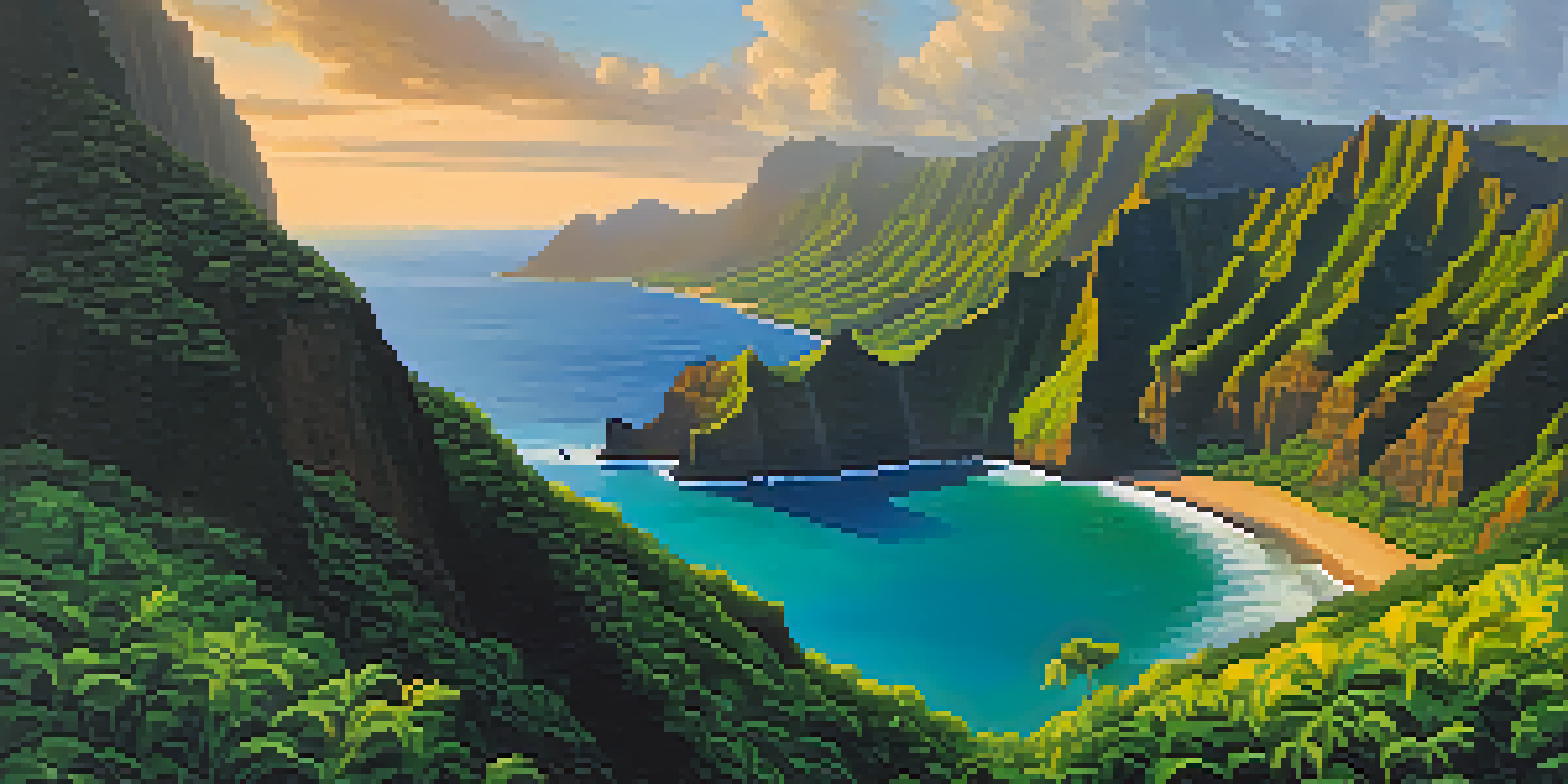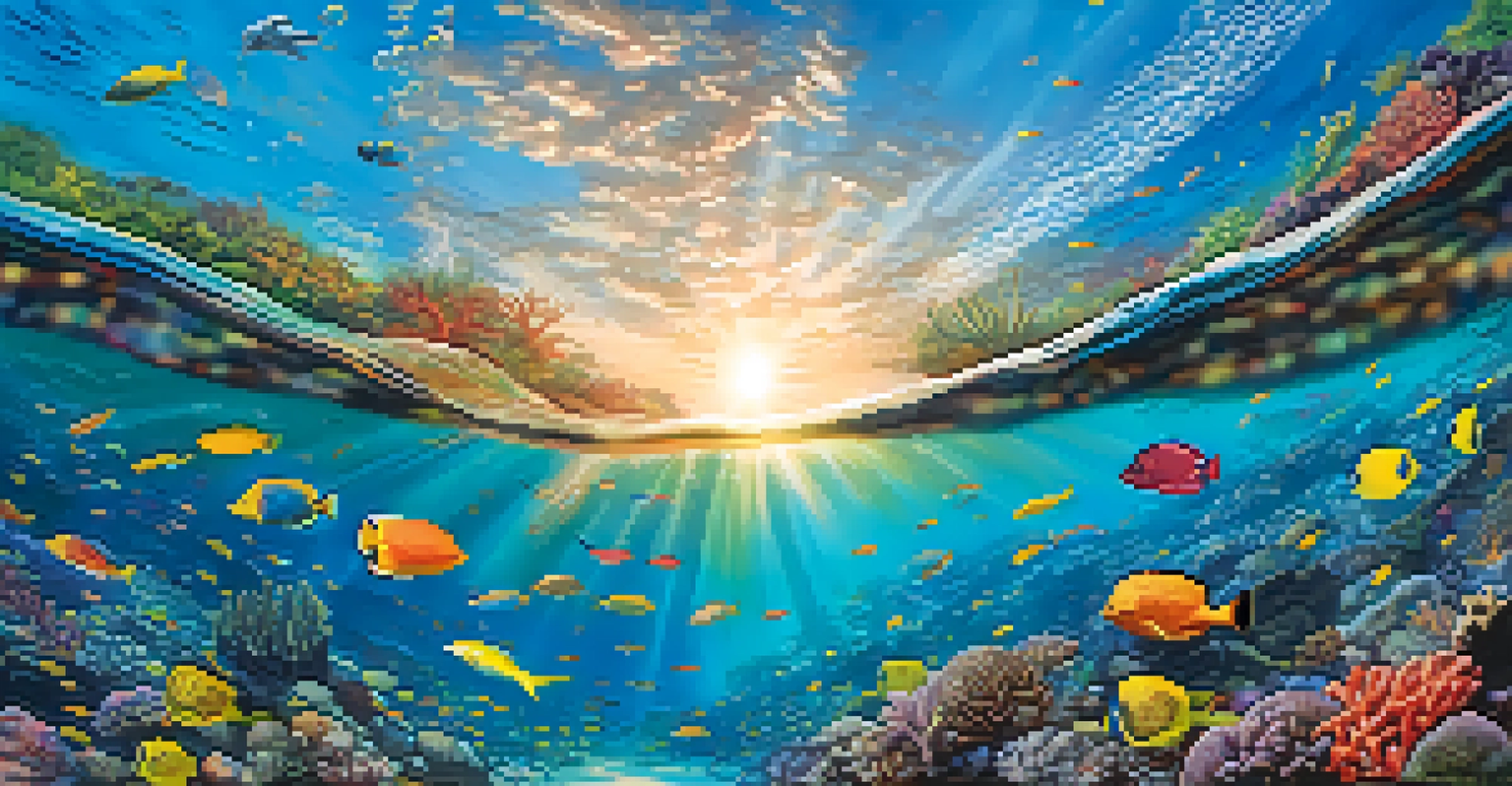Hawaii's Coastal Geography: Beaches, Cliffs, and Marine Life

The Unique Formation of Hawaii's Coastlines
Hawaii's coastlines are sculpted by volcanic activity and erosion, creating some of the most breathtaking landscapes. The islands are formed from underwater volcanoes, which erupt and build up over millions of years. These geological processes lead to diverse coastal features, from soft sandy beaches to rugged cliffs.
The ocean stirs the heart, inspires the imagination and brings eternal joy to the soul.
One of the most striking aspects of Hawaii's geography is its dramatic cliffs, especially on the Na Pali Coast of Kauai. Here, steep green cliffs plunge directly into the ocean, creating a stunning contrast with the blue waters below. This unique topography not only enhances the visual appeal but also affects local weather patterns and ecosystems.
The interplay of land and sea in Hawaii's coastal regions supports diverse habitats, making it a hotspot for biodiversity. From lush coastal rainforests to vibrant coral reefs, the variety of ecosystems showcases the dynamic relationship between the islands and the ocean.
Hawaii's Famous Beaches: A Paradise for All
Hawaii is renowned for its stunning beaches, each with its own unique character and charm. From the iconic Waikiki Beach on Oahu, known for its surf culture and vibrant nightlife, to the secluded shores of Hanauma Bay, there’s a beach for everyone. These sandy havens offer a perfect escape for sunbathers, swimmers, and surfers alike.

The soft, golden sands and crystal-clear waters of these beaches are not just beautiful; they also provide recreational opportunities and support local economies. Many beaches are protected, ensuring that they remain pristine and accessible for future generations. The balance between tourism and conservation is crucial for sustaining these natural treasures.
Hawaii's Coastlines Shape Ecosystems
The unique coastal landscapes of Hawaii, formed by volcanic activity and erosion, create diverse habitats that support rich biodiversity.
Moreover, each beach tells a story, often steeped in Hawaiian culture and history. For instance, Lanikai Beach is not only famous for its beauty but also for its connection to Hawaiian legends, making it a place where visitors can enjoy both nature and storytelling.
The Rich Marine Life of Hawaii's Waters
Hawaii's coastal waters are teeming with vibrant marine life, making it a paradise for snorkelers and divers. The coral reefs surrounding the islands provide habitat for a diverse array of species, including colorful fish, sea turtles, and even the occasional manta ray. This underwater world is a testament to the health of Hawaii's marine ecosystems.
In every drop of water, there is a story of life.
One of the most fascinating aspects of Hawaii’s marine life is the seasonal migration of humpback whales. Every year, these majestic creatures journey from Alaska to the warm waters of Hawaii to breed and give birth. Whale-watching tours offer visitors a chance to witness these spectacular animals up close, highlighting the importance of marine conservation.
However, the delicate balance of these marine ecosystems is threatened by pollution and climate change. Efforts to protect coral reefs and marine habitats are crucial to ensuring that future generations can experience the rich biodiversity that makes Hawaii so special.
The Impact of Erosion on Hawaii's Coastlines
Erosion is a natural process that shapes Hawaii's coastlines, but it can also pose significant challenges. Factors such as rising sea levels and increased storm intensity due to climate change are accelerating erosion rates. This impact can lead to the loss of beach areas and coastal habitats, affecting both wildlife and human communities.
Local governments and organizations are actively working to mitigate erosion through various strategies. These include the construction of barriers, beach replenishment projects, and the restoration of natural habitats. These efforts aim to protect not only the beaches but also the homes and businesses that rely on them.
Cultural Importance of Coastal Areas
Hawaii's coastal regions hold deep cultural significance, reflecting the traditional practices and spiritual connections of the Hawaiian people.
Understanding the causes of erosion is essential for developing effective solutions. By educating the public on the importance of preserving coastal areas and adopting sustainable practices, Hawaii can better protect its stunning coastlines for future generations.
Cultural Significance of Hawaii's Coastal Areas
The coastal areas of Hawaii are not just beautiful landscapes; they hold deep cultural significance for the Hawaiian people. Traditionally, these waters have been vital for fishing, transportation, and spiritual practices. The connection between the land and the sea is woven into the fabric of Hawaiian culture, reflecting a profound respect for nature.
Many beaches and coastal sites are considered sacred, with stories and legends that have been passed down through generations. For instance, the beach at Makena is known for its cultural history and is often the site of traditional Hawaiian ceremonies. Visitors are encouraged to appreciate and respect these cultural ties while enjoying the natural beauty.
As tourism grows, it’s essential to balance the preservation of these cultural sites with the influx of visitors. Local initiatives often focus on educating tourists about the cultural heritage of Hawaii, fostering a sense of responsibility towards respecting and protecting these invaluable coastal areas.
The Role of Conservation in Hawaii's Coastal Ecosystems
Conservation efforts play a crucial role in maintaining the health of Hawaii's coastal ecosystems. With increasing human activity and environmental threats, protecting these areas is more important than ever. Organizations and volunteers work tirelessly to restore habitats, protect endangered species, and promote sustainable tourism practices.
One notable initiative is the establishment of marine protected areas (MPAs) around the islands. These designated zones help preserve critical marine habitats and allow ecosystems to thrive without the pressures of overfishing and pollution. MPAs serve as a sanctuary for marine life and a space for researchers to study the impacts of human activity.
Conservation Efforts Are Vital
Active conservation initiatives are essential for protecting Hawaii's coastal ecosystems from environmental threats and ensuring their sustainability.
Community involvement is also a key element of successful conservation efforts. Educational programs and volunteer opportunities bring residents and visitors together to participate in beach clean-ups and habitat restoration projects. By fostering a sense of stewardship, Hawaii can ensure that its coastal environments remain vibrant and healthy for generations to come.
Adventure Activities Along Hawaii's Coastlines
Hawaii's coastal geography offers countless opportunities for adventure, attracting thrill-seekers from around the world. From surfing the famous waves of the North Shore to kayaking along the stunning Na Pali Coast, there’s no shortage of activities to get your adrenaline pumping. Each experience allows visitors to connect with the natural beauty and power of the ocean.
Snorkeling and scuba diving are also popular ways to explore the underwater world. With crystal-clear waters teeming with colorful marine life, these activities provide a unique perspective on Hawaii's ecosystems. Guided tours often include visits to coral reefs, where divers can witness the incredible biodiversity that thrives beneath the surface.

For those looking for a more leisurely experience, coastal hikes offer breathtaking views and a chance to immerse oneself in Hawaii's natural beauty. Trails along the cliffs provide panoramic vistas of the ocean, while paths through lush forests lead to hidden waterfalls and serene beaches. These adventures not only showcase Hawaii's stunning landscapes but also encourage a deeper appreciation for its coastal environment.